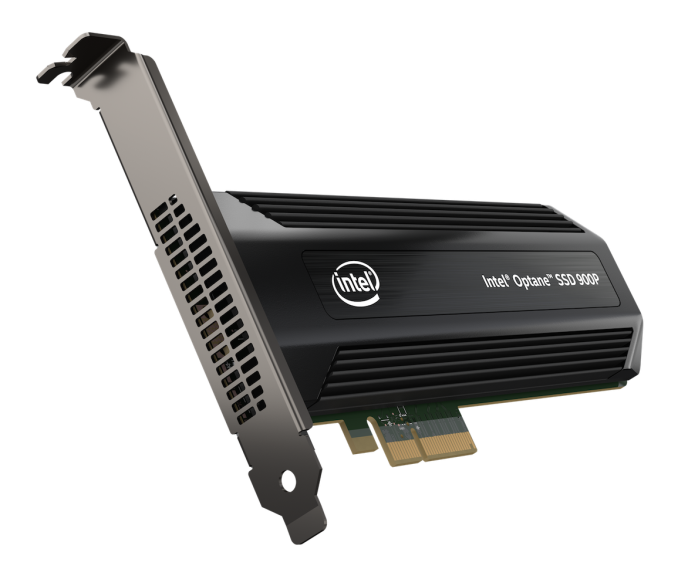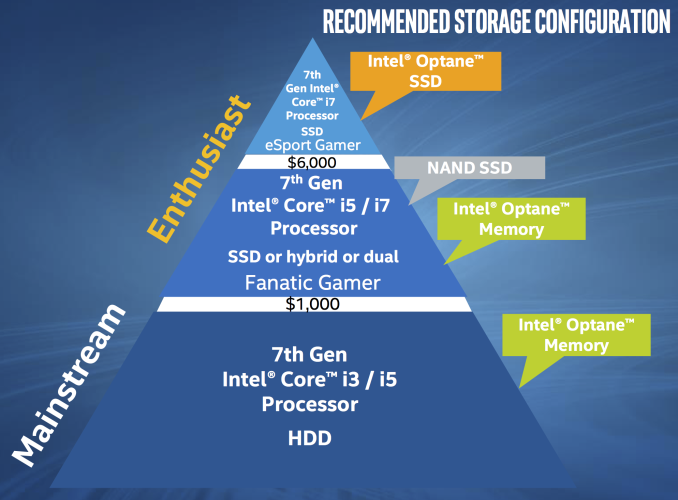The Intel Optane SSD 900P 280GB Review
by Billy Tallis on October 27, 2017 9:30 AM EST
Whenever Intel develops a new generation of SSDs based entirely on in-house technology, the result is usually a product that turns heads. Several times, Intel has set a new standard for SSD performance, starting with its original X25-M. Their most recent shake-up of the consumer SSD market was the Intel SSD 750, the first consumer NVMe SSD. Such significant releases don't happen every year, and in the intervening years Intel's competitors always catch up and surpass Intel.
However this year's revolution from Intel will be very hard for the competition to match anytime soon. All of Intel's previous record-setting SSDs have relied on the drive's controller to stand out from the crowd. This time, Intel's advantage comes from the storage medium: its 3D XPoint memory technology, a new nonvolatile memory that offers much higher performance than flash memory.
The Intel Optane SSD 900P
The new Intel Optane SSD 900P is a premium NVMe PCIe SSD offering the highest level of performance, with a moderate capacity. The Optane SSD 900P is intended for high-end desktop systems and workstations with very disk-heavy workloads. The Optane SSD 900P isn't for everyone and won't be displacing any existing products - it exists alone in a new product tier, with prices that are more than twice what the fastest flash memory based SSDs are selling for.
Optane is Intel's brand name for products featuring 3D XPoint memory. The Intel Optane SSD 900P is actually the third Optane product to be released, but it's the first family member to go after the high end consumer market segment. The Intel Optane Memory M.2 drives released earlier this year have capacities far too small for general-purpose storage use and instead have been marketed for use as a cache device to be paired with a mechanical hard drive. Intel's caching strategy works and can bring a hard drive's responsiveness up to the level of mainstream SSDs, but it has downsides. The Optane Memory caching requires a few extra steps to setup, and the caching software will only run on Intel platforms introduced this year: Kaby Lake or newer.
The Optane SSD DC P4800X is Intel's flagship enterprise SSD, and it is priced accordingly—putting it far out of reach of consumer budgets, and even with a price tag of over $1500 for 375GB it has been quite difficult to acquire. In the enterprise storage market, the P4800X has been highly sought after, but it isn't appropriate for all use cases and is not a threat to the many enterprise SSDs that prioritize capacity over performance and endurance.
The Optane SSD 900P will still cause some sticker shock for consumers expecting prices in line with M.2 PCIe SSDs, but it is acceptable for the kinds of machines that might be packing multiple GPUs or 10+ CPU cores. The Optane SSD 900P probably wouldn't be the only drive in such a system, but it would work well as a blazing fast primary storage device.
| Intel Optane SSD 900P Specifications | ||
| Capacity | 280 GB | 480 GB |
| Controller | Intel SLL3D | |
| Memory | Intel 128Gb 3D XPoint | |
| Interface | PCIe 3.0 x4 | |
| Form Factor | HHHL Add-in card or 2.5" 15mm U.2 |
HHHL Add-in card |
| Sequential Read | 2500 MB/s | |
| Sequential Write | 2000 MB/s | |
| Random Read IOPS | 550k | |
| Random Write IOPS | 500k | |
| Power Consumption | 8W Read 13W Write 14W Burst 5W Idle |
|
| Write Endurance | 10 DWPD | |
| Warranty | 5 years | |
| Recommended Price | $389 ($1.39/GB) | $599 ($1.25/GB) |
The Intel Optane SSD 900P is initially launching with 280GB and 480GB capacities. Both sizes will be available as PCIe 3.0 x4 half-height half-length add-in cards, and the 280GB model is also available as a 2.5" U.2 drive. Higher capacities may be added later, but Intel isn't promising anything yet. The sequential transfer speeds are nothing special for a NVMe SSD these days—Samsung's 960 PRO can hit much higher read speeds and slightly higher write speeds. The random read and write IOPS are far higher than any consumer SSD has offered before.
Intel's specifications for power consumption show one big reason why the Optane SSD 900P is a desktop-only product. Laptops are not equipped to supply up to 14W to a SSD, and they usually aren't equipped to cool a drive that idles at 5W instead of 50mW. The level of performance offered by the Optane SSD 900P cannot currently fit within the power budget or space constraints of a M.2 card.
The five year warranty Intel offers is typical for a high-end SSD in today's market, but doesn't compare to the 10 year warranty that Samsung's flagship 850 PRO SATA SSD offers. On the other hand, the 10 drive writes per day write endurance rating is far higher than most consumer SSDs get; 0.3 DWPD is more typical.
The Intel Optane SSD 900P starts shipping worldwide today, and here is our review of the 280GB version.











205 Comments
View All Comments
lmcd - Friday, October 27, 2017 - link
Funny, when SSDs came out we were promised they'd be orders of magnitude faster than mechanical HDDs. The first ones weren't.Drumsticks - Sunday, October 29, 2017 - link
I think my primary point of criticism with your view is that, despite Intel not reaching their goals, it is measurably better than the competition at a better price per GB per performance.It might not have hit the endurance targets they wanted, but for 2-3x the cost of your opponent, they've achieved some 20x endurance, on par in the worst case, and 6-8 times better in many measurably important scenarios.
On top of that, you tout the benefits of SLC and claim that SLC is undeniably faster than XPoint, because if SLC wasn't held back by the cheap and underpowered controllers of yesteryear, it could really fly. How do you know the same thing is not true of 3DXP? Perhaps better understanding of its use and a better controller, and maybe a second generation of the memory, will enable Intel to reach even higher performance and endurance heights. You can't claim that SLC is better, and is simply held back by 2014 era controllers, while not allowing that 3DXP could likely be held back by it's controller as well. We have no idea what the performance ceiling for 3DXP is, because we've seen all of one generation of products.
To extend your analogy, I might be disappointed if I only received $450, but if everybody else is still only making $200, I'm going to go home happy.
Rektide - Friday, October 27, 2017 - link
This shows an Intel 900P with a total write endurance of 8.7PB, and a 850 Pro with a total write endurance of 150 TB. But a stress test of a 850 Pro in fact survived 9.1 PB[1]! Meanwhile, if you reach 8.7PB on the 900P, Intel will forcibly move your drive into read-only mode.If you look at Ark, Intel describes it's Endurance Rating to mean "Endurance rating indicates the expected data storage cycles to be expected over the life of the device." When they say that, they mean "and not a megabyte more". Whereas when Samsung says it, they, at least once, meant "but this drive may go 60x more than it's rating". I really severely dislike this twist of the knife, this drastic change Intel and Intel alone is perpetrating against it's consumers.
Does the P4800X also commit seppuku the megabyte it reaches it's Endurance Lifetime? I'm not sure if all Intel drives are so malicious, or is it consumer & enthusiast drives? How do I know which drives are programmed to self destruct on me, Intel?
[1] http://www.guru3d.com/news-story/endurance-test-of...
ddriver - Friday, October 27, 2017 - link
It is actually worse than locking in read-only mode - on the next boot cycle the drive gets bricked. So if you didn't manage to get that data in time, it is gone forever. Great feature.Spunjji - Saturday, October 28, 2017 - link
I have seen this with Intel consumer SSDs. It's amazing - it doesn't even tell you that it's failing and that you have one (yes, one) chance to backup your data before it goes forever. Usually the drive just throws an error, so your average user reboots the system and bam, the drive's not even in the BIOS anymore.Their drive failure behaviour is criminal.
voicequal - Saturday, October 28, 2017 - link
Agreed - bricking is a terrible failure mode for a consumer drive. For an enterprise drive, it *might* make sense, since its you want things to fail hard and fast so that backup systems can detect and take over.FwFred - Friday, October 27, 2017 - link
Wow, need a block button to improve SnR.Meteor2 - Tuesday, October 31, 2017 - link
Indeed -- though I simply skip any comments written by ddriver. Never any value in them (but a remarkably effective troll).Lolimaster - Saturday, October 28, 2017 - link
The 1000X was supposed to be on latency and endurance, not much more, and maybe 10X random 4K performance.CajunArson - Friday, October 27, 2017 - link
I thought you were a reliable AMD koolaid drinker?It's funny how you insult these products that you have never used but would never in a million years hurl their $7000 Radeon SSG under the bus... you know, the one that uses a consumer-grade GPU slapped together with a RAID-0 array of cheap consumer-grade NVME drives to supposedly do rendering jobs faster than a regular GPU.